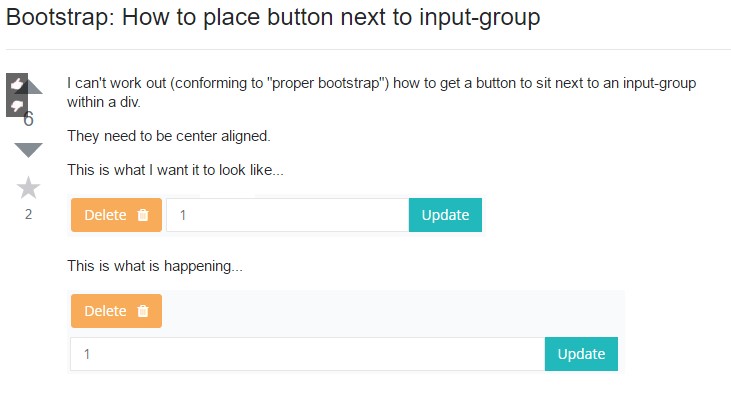Bootstrap Input Field
Introduction
Most of the elements we work with in applications to catch site visitor info are offered by the <input> tag.
You are able to freely spread form regulations simply by adding in text, tabs, or button groups on each side of textual <input>-s.
The different types of Bootstrap Input Group are determined due to the value of their option attribute.
Next, we'll reveal the received types regarding this kind of tag.
Text
<Input type ="text" name ="username">
Quite possibly the absolute most frequent style of input, which possesses the attribute type ="text", is used each time we want the user to send a basic textual info, because this component does not allow the access of line breaks.
Anytime you are launching the form, the details recorded by site visitor is easily accessible on the web server side using the "name" attribute, utilized to determine each and every related information included in the request specifications.
In order to have access to the information typed in when we treat the form along with some kind of script, to verify the information as an example, it is essential to obtain the components of the value property of the object in the DOM.
Parole
<Input type="password" name="pswd">
Bootstrap Input Form that accepts the type="password" attribute is much the same to the text type, except that it does not reveal truly the words typed by the user, but instead a group of figures "*" otherwise yet another according to the internet browser and working system .
Basic Bootstrap Input Class scenario
Install one add-on or button for either area of an input. You could also apply one on both parts of an input. Bootstrap 4 does not supports a variety of form-controls in a single input group.
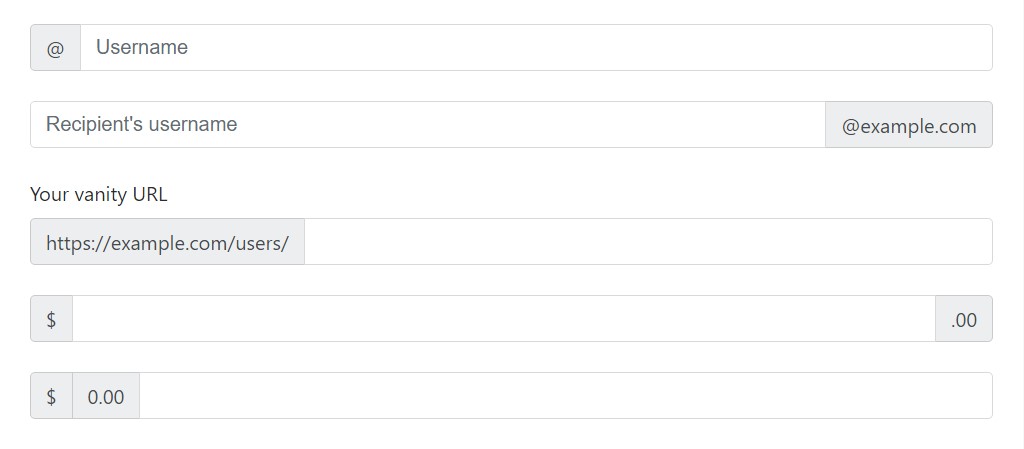
<div class="input-group">
<span class="input-group-addon" id="basic-addon1">@</span>
<input type="text" class="form-control" placeholder="Username" aria-describedby="basic-addon1">
</div>
<br>
<div class="input-group">
<input type="text" class="form-control" placeholder="Recipient's username" aria-describedby="basic-addon2">
<span class="input-group-addon" id="basic-addon2">@example.com</span>
</div>
<br>
<label for="basic-url">Your vanity URL</label>
<div class="input-group">
<span class="input-group-addon" id="basic-addon3">https://example.com/users/</span>
<input type="text" class="form-control" id="basic-url" aria-describedby="basic-addon3">
</div>
<br>
<div class="input-group">
<span class="input-group-addon">$</span>
<input type="text" class="form-control" aria-label="Amount (to the nearest dollar)">
<span class="input-group-addon">.00</span>
</div>
<br>
<div class="input-group">
<span class="input-group-addon">$</span>
<span class="input-group-addon">0.00</span>
<input type="text" class="form-control" aria-label="Amount (to the nearest dollar)">
</div>Proportions
Bring in the associated form scale classes to the .input-group itself and information located in will quickly resize-- no necessity for restating the form control scale classes on each and every component.

<div class="input-group input-group-lg">
<span class="input-group-addon" id="sizing-addon1">@</span>
<input type="text" class="form-control" placeholder="Username" aria-describedby="sizing-addon1">
</div>
<br>
<div class="input-group">
<span class="input-group-addon" id="sizing-addon2">@</span>
<input type="text" class="form-control" placeholder="Username" aria-describedby="sizing-addon2">
</div>Apply any sort of checkbox or radio solution in an input group’s addon as an alternative to of text.
Checkbox button feature
The input element of the checkbox selection is very regularly employed in case we have an solution which can possibly be marked as yes or no, for instance "I accept the terms of the buyer pact", or possibly " Maintain the active program" in applications Login.
Even though widely utilized using the value true, you can certainly certify any value for the checkbox.

<div class="col-lg-6">
<div class="input-group">
<span class="input-group-addon">
<input type="checkbox" aria-label="Checkbox for following text input">
</span>
<input type="text" class="form-control" aria-label="Text input with checkbox">
</div>
</div>Radio button solution
Anytime we require the user to choose just one of a series of selections, we can probably utilize input features of the radio form.
Whenever there is much more than one component of this one style with the identical value within the name attribute, just one can be selected.

<div class="col-lg-6">
<div class="input-group">
<span class="input-group-addon">
<input type="radio" aria-label="Radio button for following text input">
</span>
<input type="text" class="form-control" aria-label="Text input with radio button">
</div>
</div>Different addons
Multiple attachments are maintained and may possibly be incorporated with checkbox plus radio input versions.

<div class="row">
<div class="col-lg-6">
<div class="input-group">
<span class="input-group-addon">
<input type="checkbox" aria-label="Checkbox for following text input">
</span>
<span class="input-group-addon">$</span>
<input type="text" class="form-control" aria-label="Text input with checkbox">
</div>
</div>
<div class="col-lg-6">
<div class="input-group">
<span class="input-group-addon">$</span>
<span class="input-group-addon">0.00</span>
<input type="text" class="form-control" aria-label="Text input with radio button">
</div>
</div>
</div>Input group: more buttons varieties
<Input type ="button" name ="show_dialogue" value ="Click here!">
The input element using the type="button" attribute provides a tab within the form, and yet this specific switch has no direct purpose with it and is usually employed to generate events with regards to script implementation.
The button content is identified by the value of the "value" attribute.
Add-ons of the buttons
Buttons in input groups have to be covered in a .input-group-btn for effective positioning along with scale. This is demanded because of the default browser looks that can definitely not be overridden.

<div class="row">
<div class="col-lg-6">
<div class="input-group">
<span class="input-group-btn">
<button class="btn btn-secondary" type="button">Go!</button>
</span>
<input type="text" class="form-control" placeholder="Search for...">
</div>
</div>
<div class="col-lg-6">
<div class="input-group">
<input type="text" class="form-control" placeholder="Search for...">
<span class="input-group-btn">
<button class="btn btn-secondary" type="button">Go!</button>
</span>
</div>
</div>
</div>
<br>
<div class="row">
<div class="col-lg-offset-3 col-lg-6">
<div class="input-group">
<span class="input-group-btn">
<button class="btn btn-secondary" type="button">Hate it</button>
</span>
<input type="text" class="form-control" placeholder="Product name">
<span class="input-group-btn">
<button class="btn btn-secondary" type="button">Love it</button>
</span>
</div>
</div>
</div>Drop-down buttons

<div class="row">
<div class="col-lg-6">
<div class="input-group">
<div class="input-group-btn">
<button type="button" class="btn btn-secondary dropdown-toggle" data-toggle="dropdown" aria-haspopup="true" aria-expanded="false">
Action
</button>
<div class="dropdown-menu">
<a class="dropdown-item" href="#">Action</a>
<a class="dropdown-item" href="#">Another action</a>
<a class="dropdown-item" href="#">Something else here</a>
<div role="separator" class="dropdown-divider"></div>
<a class="dropdown-item" href="#">Separated link</a>
</div>
</div>
<input type="text" class="form-control" aria-label="Text input with dropdown button">
</div>
</div>
<div class="col-lg-6">
<div class="input-group">
<input type="text" class="form-control" aria-label="Text input with dropdown button">
<div class="input-group-btn">
<button type="button" class="btn btn-secondary dropdown-toggle" data-toggle="dropdown" aria-haspopup="true" aria-expanded="false">
Action
</button>
<div class="dropdown-menu dropdown-menu-right">
<a class="dropdown-item" href="#">Action</a>
<a class="dropdown-item" href="#">Another action</a>
<a class="dropdown-item" href="#">Something else here</a>
<div role="separator" class="dropdown-divider"></div>
<a class="dropdown-item" href="#">Separated link</a>
</div>
</div>
</div>
</div>
</div>Moreover, buttons can be fractional
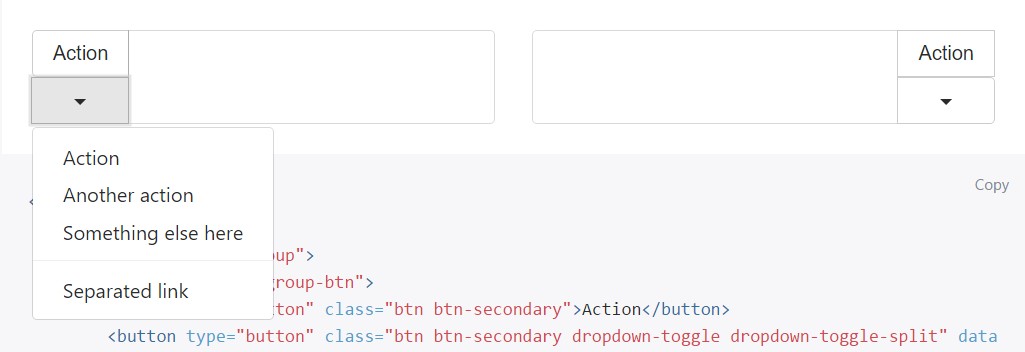
<div class="row">
<div class="col-lg-6">
<div class="input-group">
<div class="input-group-btn">
<button type="button" class="btn btn-secondary">Action</button>
<button type="button" class="btn btn-secondary dropdown-toggle dropdown-toggle-split" data-toggle="dropdown" aria-haspopup="true" aria-expanded="false">
<span class="sr-only">Toggle Dropdown</span>
</button>
<div class="dropdown-menu">
<a class="dropdown-item" href="#">Action</a>
<a class="dropdown-item" href="#">Another action</a>
<a class="dropdown-item" href="#">Something else here</a>
<div role="separator" class="dropdown-divider"></div>
<a class="dropdown-item" href="#">Separated link</a>
</div>
</div>
<input type="text" class="form-control" aria-label="Text input with segmented button dropdown">
</div>
</div>
<div class="col-lg-6">
<div class="input-group">
<input type="text" class="form-control" aria-label="Text input with segmented button dropdown">
<div class="input-group-btn">
<button type="button" class="btn btn-secondary">Action</button>
<button type="button" class="btn btn-secondary dropdown-toggle dropdown-toggle-split" data-toggle="dropdown" aria-haspopup="true" aria-expanded="false">
<span class="sr-only">Toggle Dropdown</span>
</button>
<div class="dropdown-menu dropdown-menu-right">
<a class="dropdown-item" href="#">Action</a>
<a class="dropdown-item" href="#">Another action</a>
<a class="dropdown-item" href="#">Something else here</a>
<div role="separator" class="dropdown-divider"></div>
<a class="dropdown-item" href="#">Separated link</a>
</div>
</div>
</div>
</div>
</div>Submit
<Input type ="submit" name ="send" value ="Submit">
The input feature with the option "submit" attribute is very close to the button, still, as soon as triggered this particular feature initiates the call that sends out the form information to the address implied in the action attribute of <form>.
Image
You can remove and replace the submit form switch by using an image, making it feasible to develop a far more eye-catching appearance to the form.
Reset
<Input type="reset" name="reset" value="Clear">
The input with type="reset" gets rid of the values typed before in the features of a form, making it possible for the site visitor to clean the form.
<Input> and <button>
<Button type="button" name="send"> Click here </button>
The <input> tag of the switch, submit, and reset kinds may possibly be substituted with <button> tag.
Within this instance, the text of the tab is currently indicated as the information of the tag.
It is still important to determine the value of the type attribute, even when it is a button.
File
<Input type ="file" name ="attachment">
When it is crucial for the site visitor to transfer a data to the application on the server part, it is required to utilize the file type input.
For the precise directing of the information, it is regularly in addition required to provide the enctype="multipart/form-data" attribute in the <form> tag.
Hidden
<Input type="hidden" name ="code" value ="abc">
Commonly we require to send and receive information which is of no absolute usage to the user and therefore must not be presented on the form.
For this kind of purpose, there is the input of the hidden type, that only brings a value.
Accessibility
Assuming that you don't include a label for every single input, display screen readers will likely have problem with your forms. For such input groups, be sure that every added label or functionality is sent to assistive technologies.
The examples in this section provide a few suggested, case-specific approaches.
Look at a couple of on-line video training relating to Bootstrap Input
Linked topics:
Bootstrap input: main documentation
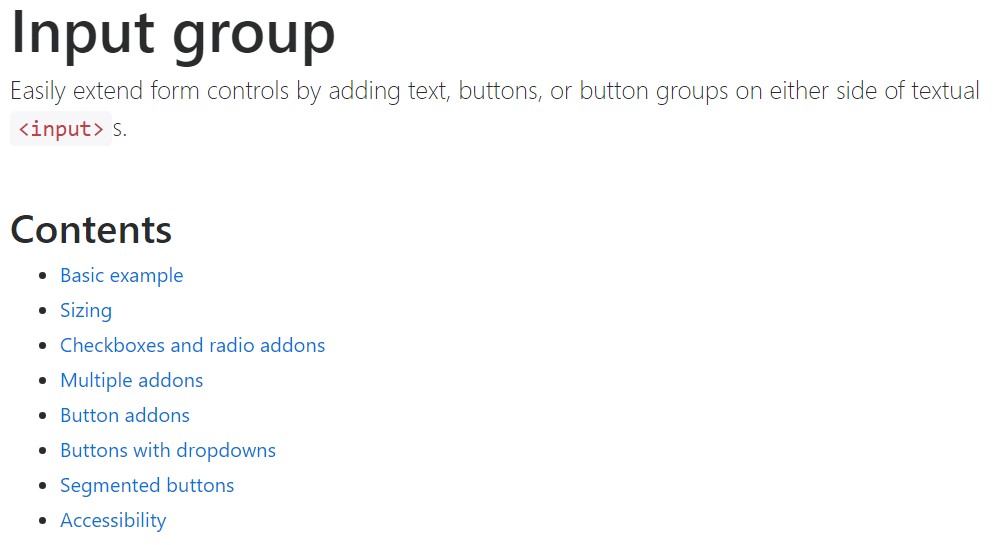
Bootstrap input tutorial
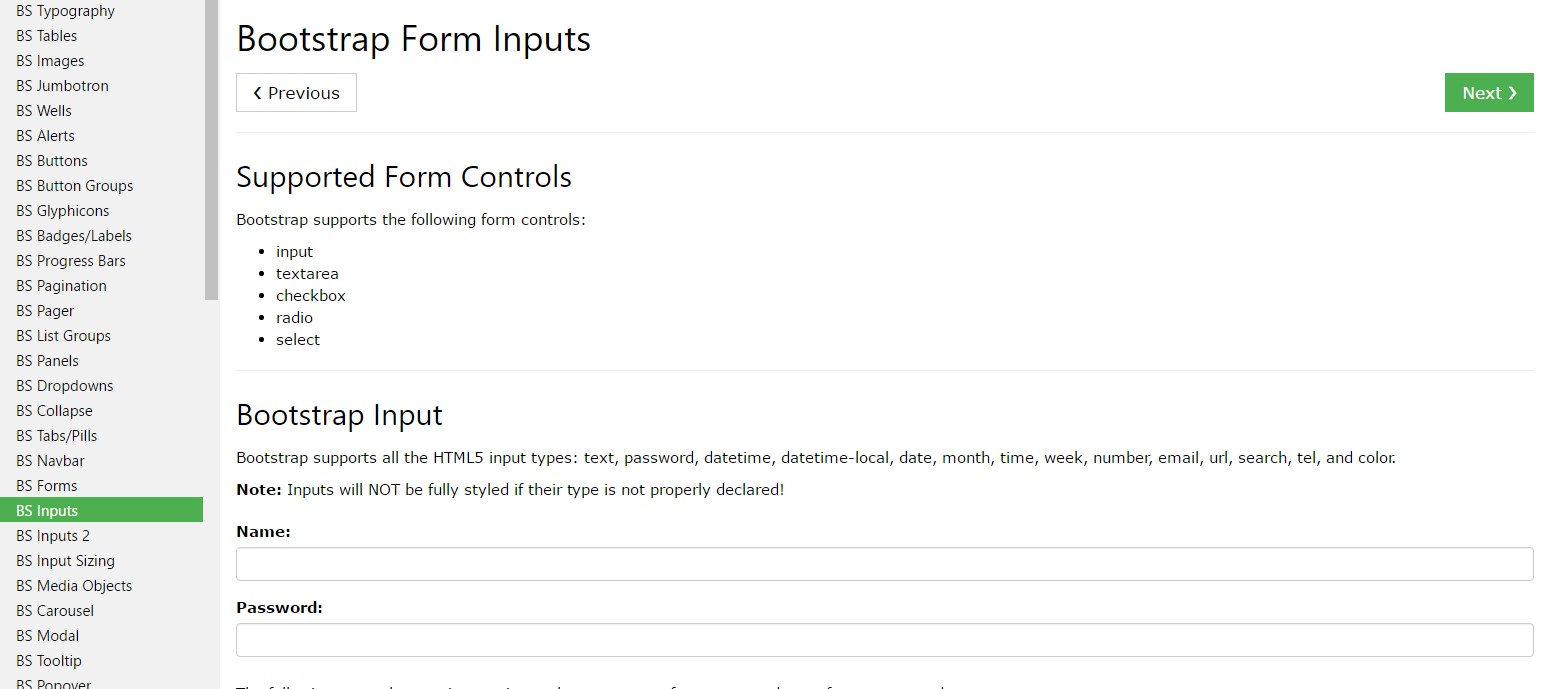
Bootstrap: The way to place button unto input-group
